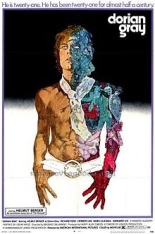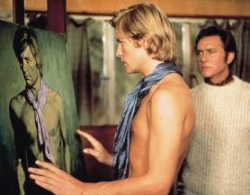
 Rather than being a straight (no pun intended) adaptation of Oscar Wilde’s classic novel, Italy’s The Secret of Dorian Gray is credited as “a modern allegory based on the works of Oscar Wilde,” whose name the characters even drop. Ditch the Picture of Wilde’s title; give the greedy protagonist a Secret. Even more than one.
Rather than being a straight (no pun intended) adaptation of Oscar Wilde’s classic novel, Italy’s The Secret of Dorian Gray is credited as “a modern allegory based on the works of Oscar Wilde,” whose name the characters even drop. Ditch the Picture of Wilde’s title; give the greedy protagonist a Secret. Even more than one.
Set in London at the dawn of the ’70s, Dorian (Helmut Berger, The Damned) is a well-off, but level-headed 21-year-old who seems to have it all. He’s fallen in love with a virginal actress (Marie Liljedahl, The Seduction of Inga), doesn’t want for money, and enjoys his youthful good looks, which are freshly captured on an oil painting done by an artist pal (Richard Todd, Stage Fright).
 When an arrogant art buyer (Herbert Lom, the Pink Panther franchise’s seven-time Dreyfus) admires the work and its shirtless subject, he notes, “one day, you will become an old and hideous puppet.” A suddenly overly vain Dorian responds that he wishes he could stay forever young while the painting ages, and lo and behold, that’s what happens … provided he delights in vice and immoral activity. The more he humps — no regard to either gender — the older his canvas visage gets, to the point where it resembles a zombie from an EC cover of Tales from the Crypt.
When an arrogant art buyer (Herbert Lom, the Pink Panther franchise’s seven-time Dreyfus) admires the work and its shirtless subject, he notes, “one day, you will become an old and hideous puppet.” A suddenly overly vain Dorian responds that he wishes he could stay forever young while the painting ages, and lo and behold, that’s what happens … provided he delights in vice and immoral activity. The more he humps — no regard to either gender — the older his canvas visage gets, to the point where it resembles a zombie from an EC cover of Tales from the Crypt.
This is one big Piccadilly Circus version of an 1890 tale that only could have been made when it was, at the peak of the sexual revolution (just before the birth-control pill became available for all in the UK), but before anyone ever heard of AIDS. A gay club is not-so-subtly named The Black Cock, but the actual depiction of sex is less graphic than what the movie’s controversy (and porno-theater bookings) would suggest. In its swingin’, groovy, right-place-at-the-right-time world, this Secret is the finest interpretation of that Picture I’ve seen. —Rod Lott
